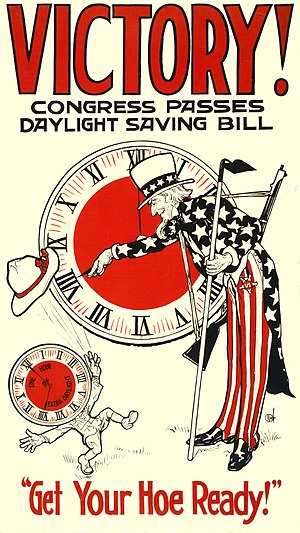 |
| Cover of Richard M. Nixon |
In December 1973, President Richard Nixon explained to the American people his administration’s critical initiative to confront the “energy crisis” du jour (precipitated by the 1973–74 Arab oil embargo): “Many [energy savings measures] require inconvenience and sacrifice. But daylight saving time... will mean only a minimum of inconvenience and will involve equal participation by all. Unlike many of our other initiatives to deal with the energy crisis and to accomplish the goal of self-sufficiency in energy... these savings will not require research, new technology, diplomacy, or exploration.”
 |
| Cover of Jimmy Carter |
Historical Background
Benjamin Franklin is credited as the first to identify the potential fuel savings associated with adjusting the clock. … |
| Retailers generally favor DST. United Cigar Stores hailed a 1918 DST bill. (Photo credit: Wikipedia) |
Energy Policy Act of 2005: Same Old, Same Old
From the early 1980s … oil prices remained around $25 a barrel. However, prices began a run-up in mid- |
| An illustration of the beginning of Daylight Saving Time. (Photo credit: Wikipedia) |
… Congress, however, essentially “dropped back 30 years” and … reverted to President Nixon’s political acumen to prioritize a policy promising “no cost/no inconvenience.”
… Our clocks now “spring ahead” on the second Sunday in March and “fall back” on the first Sunday in November. This 34-week period observed by most of the United States likely represents the world’s longest daylight saving period, exceeding the period in European nations by three or four weeks.
Energy Policy or Legislative Placebo?
At one level, EPACT’s expansion of daylight saving time could be viewed as a success: Almost no |
| An illustration of the end of Daylight Saving Time. (Photo credit: Wikipedia) |
… Our nearly half-century experience responding to energy crises demonstrates that national energy policy must be developed with the understanding that there are no quick fixes and that success demands public and private investment, measured risk-taking (not all of which proves successful), and technological advances.
Energy policy must be crafted based on current facts and circumstances. President Nixon’s reliance on daylight saving made sense—increasing daylight hours in the 1970s represented the easily attainable “low-hanging fruit” of energy efficiency. However, EPACT expanded daylight saving only because “it worked before” and to avoid the political awkwardness of pursuing meaningful energy measures. … . Daylight saving should be assessed on its comparative social and economic costs and benefits. As a means to reduce energy consumption, daylight saving, particularly any further expansion of its duration, must be dismissed as a distracting placebo.
— Steven F. Greenwald (stevegreenwald@dwt.com) and Jeffrey P. Gray (jeffgray@dwt.com) are partners in Davis Wright Tremaine’s Energy Practices Group.











No comments:
Post a Comment